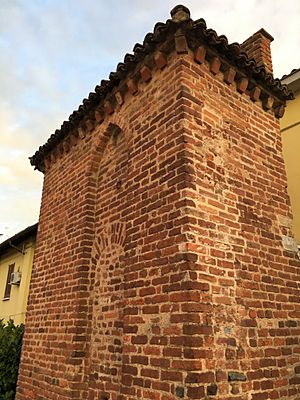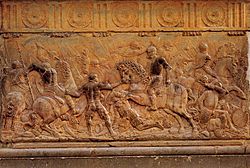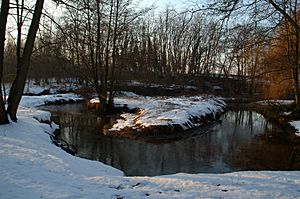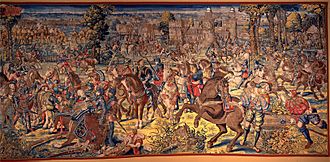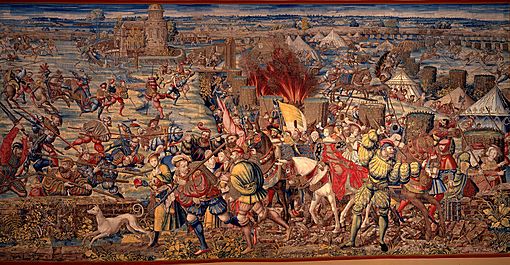Battle of Pavia facts for kids
Quick facts for kids Battle of Pavia |
|||||||
|---|---|---|---|---|---|---|---|
| Part of the Italian War of 1521–1526 | |||||||
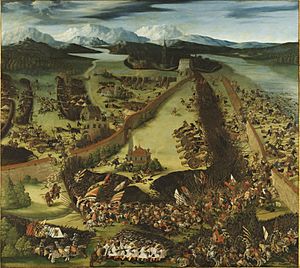 Ruprecht Heller, The Battle of Pavia (1529), Nationalmuseum, Stockholm |
|||||||
|
|||||||
| Belligerents | |||||||
| Commanders and leaders | |||||||
| Strength | |||||||
|
26,200
|
28,300
|
||||||
| Casualties and losses | |||||||
| 8,000 killed or wounded | 1,500 killed or wounded | ||||||
The Battle of Pavia was a major battle fought on February 24, 1525. It was a key moment in the Italian War of 1521–1526. This war was between the Kingdom of France and the powerful Habsburg Empire. The Habsburg Empire was led by Charles V. He was also the ruler of Spain, Austria, and other lands.
The French army, led by their king, Francis I, had surrounded the city of Pavia. Pavia was then part of the Duchy of Milan in the Holy Roman Empire. Francis I began his siege in October 1524 with about 26,200 soldiers. His army included French soldiers and many foreign fighters, like Swiss, German, and Italian mercenaries.
Emperor Charles V wanted to help Pavia. He sent a relief army of 22,300 troops. These troops joined the 6,000 soldiers already defending Pavia. The Imperial army was led by Charles de Lannoy and Charles III, Duke of Bourbon. The battle was fought just outside Pavia, in the Visconti Park.
During the battle, King Francis I led a brave cavalry charge. However, his attack was stopped by skilled German and Spanish soldiers. These soldiers used long pikes and early firearms called arquebuses. The French army was surrounded and defeated. Many French nobles were killed, and King Francis I himself was captured.
This battle was a huge victory for the Habsburg Empire. It showed their growing power in Italy and Europe. Francis I was taken to Spain and later signed the Treaty of Madrid. This treaty forced him to give up claims to Milan and Burgundy to gain his freedom. However, Francis I soon broke the treaty and the fighting continued.
Contents
Why the Battle of Pavia Happened
France's Goal: Taking Back Lombardy
The French had lost control of Lombardy, a region in Italy, in 1522. This happened after they were defeated at the Battle of Bicocca. King Francis I was determined to get it back. So, in late 1523, he ordered his army to invade the area again.
However, the French commander, Guillaume Gouffier, Seigneur de Bonnivet, was defeated. His troops had to retreat back to France. This left the door open for the Imperial forces.
Imperial Counter-Attack and French Advance
Charles de Lannoy and Charles III, Duke of Bourbon then led an Imperial invasion into Provence, a region in France. They tried to capture the city of Marseille. But this siege took too long.
King Francis I arrived with his main French army, forcing the Imperial troops to retreat to Italy. In October 1524, Francis I crossed the Alps with over 40,000 soldiers. He quickly moved towards Milan.
The Imperial commanders, Bourbon and Pescara, couldn't stop the French. Their troops were tired from the Provence campaign. Lannoy decided Milan couldn't be defended and pulled back his 16,000 men.
The Siege of Pavia Begins
After entering Milan, King Francis I decided to attack Pavia. This was against the advice of some of his generals. Antonio de Leyva was defending Pavia with about 9,000 Imperial soldiers.
The French army reached Pavia by the end of October. By November 2, they had completely surrounded the city. The French tried to break through the city walls with artillery. On November 21, Francis I ordered an attack, but it failed. The French then decided to wait for the defenders to run out of food.

Changing Sides and Reinforcements
In December, a Spanish force landed near Genoa. Francis I sent troops to stop them, and the Spanish surrendered. Francis also made a secret deal with Pope Clement VII. The Pope promised not to help Charles V if Francis helped him conquer Naples.
Francis I sent some of his troops south to help the Pope. This weakened his army at Pavia. Meanwhile, the Imperial forces got stronger. In January 1525, Georg Frundsberg arrived with 15,000 new German soldiers.
The Imperial army began to move closer to Pavia. They cut off the French supply lines. Francis I had placed most of his army in the large, walled Visconti Park outside Pavia. This put them between the city's defenders and the approaching Imperial army.
Fighting continued through February. On February 21, the Imperial commanders decided to attack. They were running low on supplies and thought the French had more soldiers. Their plan was to attack Mirabello Castle inside the park. This would hopefully scare the French enough for the Imperial army to retreat safely.
The Battle Unfolds
Early Morning Moves
On the night of February 23, the Imperial troops started moving. They marched north along the walls of the Visconti Park. To hide their movement, they set their tents on fire, making the French think they were leaving.
At the same time, Imperial engineers quickly made a hole in the park walls. This was at the Porta Pescarina. By 5:00 AM, about 3,000 arquebusiers (soldiers with early firearms) had entered the park. They moved quickly towards Mirabello Castle. Imperial light cavalry also spread out to stop any French movements.
First Clashes
French cavalry soon met the Imperial cavalry, and small fights broke out. Swiss pikemen (soldiers with long spears) came to help the French cavalry. They even captured some Spanish artillery.
However, they missed the Imperial arquebusiers, who had reached Mirabello Castle by 6:30 AM and taken it over. By 7:00 AM, a full-scale battle between foot soldiers had started near the wall breach.
King Francis I Attacks
Meanwhile, the main Imperial forces, including heavy cavalry and Spanish infantry, were moving through the woods. They were getting closer to where King Francis I was camped. The French didn't realize how big the Imperial attack was at first.
Around 7:20 AM, French artillery spotted the Imperial advance and began firing. This alerted Francis I. He immediately launched a charge with all his French gendarmes (heavy cavalry). They scattered the smaller Imperial cavalry force by 7:40 AM.
However, Francis's quick charge had a big problem. It blocked his own artillery from firing. It also pulled him away from his main French infantry. This infantry included the "Black Band" of German pikemen.
The Final Moments
By 8:00 AM, Imperial pikemen and arquebusiers surrounded the French cavalry. The French gendarmes had no room to move in the woods. They were systematically killed. The French infantry, trying to help Francis, were met by more Imperial soldiers and were also defeated.
The "Black Band" of German pikemen, fighting for France, were surrounded and wiped out. King Francis I continued to fight even after his horse was killed. He was surrounded by Spanish and German soldiers. He was then captured and taken away from the battlefield.
At the same time, the Imperial garrison from Pavia attacked the French siege lines. They defeated the Swiss soldiers guarding them. The remaining French and Swiss troops tried to escape across the river, suffering heavy losses. By 9:00 AM, the battle was over.
Aftermath of the Battle
The King's Capture
The capture of King Francis I was a huge event. Many people claimed credit for it. Some said it was Charles de Lannoy himself, who supposedly knelt before the king. Others said it was three Spanish soldiers. Some accounts mention "some Germans" or the Italian soldier Cesare Hercolani.
Emperor Charles V himself honored different people for the achievement over the years. He even stated that Francis was captured by his "principal captains," including the Duke of Bourbon, Charles de Lannoy, and the Marquis of Pescara.
Consequences for France
The French defeat was complete. Besides Francis I, many important French nobles were captured or killed. The Duke of Albany, who had been sent south, lost most of his army and returned to France.
The remaining French forces retreated across the Alps. King Francis I was held prisoner in a tower in Pizzighettone. He was then moved to Genoa and finally to Spain. He stayed in a Madrid prison until the Treaty of Madrid was signed.
The Treaty of Madrid
Under the treaty, Francis I had to give up his claims to Flanders, Milan, and Burgundy. This was a big loss for France. However, Francis I broke the treaty soon after he was freed. This led to a new war between France and the Habsburg Empire that lasted until 1529.
Art and the Battle of Pavia
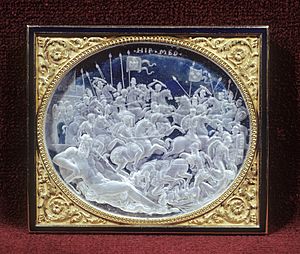
The Battle of Pavia was a very important event. It inspired many works of art. Cardinal Ippolito de' Medici commissioned a beautiful rock crystal relief showing the battle. This piece of art made the event seem timeless and important.
An oil painting by an unknown Flemish artist also shows the battle. It is very detailed and is believed to be an accurate record of the fighting. A set of seven amazing Brussels tapestries were also made. These tapestries celebrate the Imperial-Spanish victory. They are now kept in the Capodimonte Museum in Naples, Italy.
The Battlefield Today
Much of the battle took place in the huge Visconti Park. This was a hunting reserve for the Dukes of Milan. Most of the park's woods were cut down over the centuries.
However, three natural reserves still exist today. These are the heronry of the Carola, Porta Chiossa, and the Vernavola Park. The Vernavola Park is where some of the most important parts of the battle happened.
In 2015, two cannonballs were found near the park. They were likely fired by French artillery during the battle. About two kilometers north, you can find the Repentita farmhouse. Tradition says King Francis I was captured and held there. The building still has parts from the 1400s.
In the nearby town of San Genesio ed Uniti, you can see remains of the park gate. This is where the Imperial army broke through the walls on the night of the battle. Traces of the battle are less clear in Pavia itself. The city walls were replaced in the mid-1500s.
However, you can still see the Visconti Castle. It holds the tombstone of Eitel Friedrich III, Count of Hohenzollern, a German captain. Two medieval city gates, Porta Nuova and Porta Calcinara, also remain.
The eastern part of Pavia has old monasteries that hosted French and German soldiers. These include Santi Spirito and Gallo, San Giacomo della Vernavola, San Pietro in Verzolo, and San Lazzaro. In the western part, you can find the church of San Lanfranco, where Francis I was based. The church of San Teodoro has a large fresco. It shows Pavia during the 1522 siege, looking much like it did during the battle.
Images for kids
-
The Battle of Pavia, by a follower of Joachim Patinir
-
Leather Box for the Pennant of Francis I at the Battle of Pavia Walters Art Museum, Baltimore.
See also
 In Spanish: Batalla de Pavía para niños
In Spanish: Batalla de Pavía para niños


